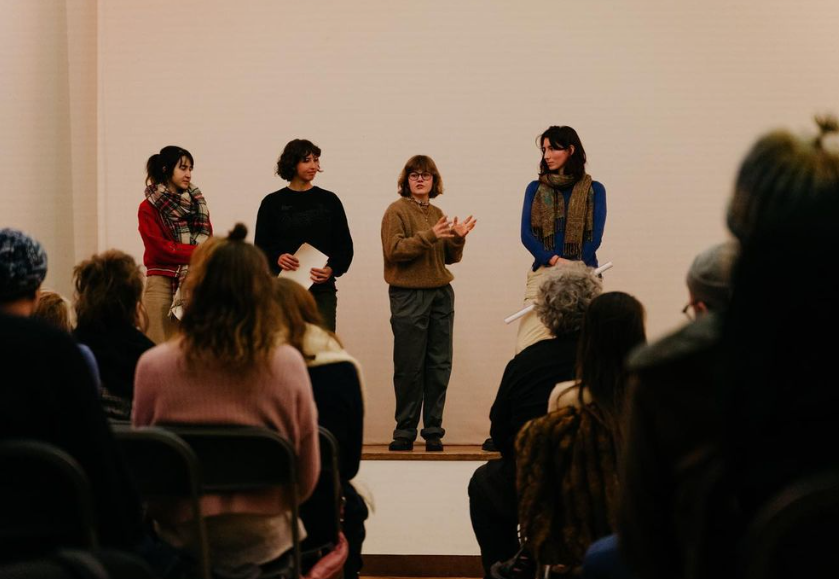The KABK's courtyard was recently the breeding ground for a new green initiative: Green Office Ginkgo. Fanny Noel (graduate BA Fine Arts), Pam Breedveld (graduate BA I/M/D) and Anđela Brnas (first year MA Interior Architecture) together with older members Emma Hanny (used to study BA I/M/D) and Ilva Nieuwstraten (3rd year BA I/M/D) met when the Binnentuin, the I/M/D vertical garden, needed to be rebuild. "That moment we met was great. It's super nice to be able to talk to others about nature and sustainable art and design practices," Anđela says.
It was no coincidence that they met in the courtyard; in Anđela and Fanny's personal lives, nature plays a big role. Anđela: "During my bachelor studies, I became more interested in nature to my design practice. I tried to embed sustainability more in my life. That made me happy and disappointed at the same time. Now to be able to work with this group to make the academy more sustainable is like a dream job for me."
Movement
And a job it is: unlike volunteer-led initiatives, the Green Office is funded by the KABK and jointly run by students and staff. Currently, the Green Office consists of six members with Lizzy Kok (Head of Operations) as coordinator. After the open call that was out last month, Akash Kumar (MA Industrial Design), Melania Trejo Mendez (BA Fine Arts) and Zuzanna Kamińska (BA Textile and Fashion) were hired. That way, the Green Office will continue to exist when Pam and Fanny graduate. By the way, it is not something typically KABK what happens here, the Green Office is part of a larger movement that stands for institutionalising sustainability in higher educational institutes by empowering students and staff as change-makers.
Fanny took roughly the same path as Anđela, she even had to deal with climate depression. "I was working as a designer, but at some point, I thought about what I was investing and what I was contributing to society. I realised it was meaningless - I was actually contributing to destroying the earth." And this is what brought Fanny to art school. "I hope to contribute to changing the mechanism this way.”

Everything is connected
They realise well that the climate problem is bigger than what goes on inside the walls of the academy. "Our aim is to raise awareness among students and staff that their choices affect things that are not visible. We want it to become normal to deal with things in a sustainable way and think before ordering materials that have to come from the other side of the world, for example," says Fanny.
Anđela adds: "Exactly, everything is connected. There is a lot of waste at the academy. We do see that to change this, the whole way of the educational system has to change. Students make certain choices because they have little time or money to look for second-hand or sustainable materials." Fanny: "It requires a cultural shift: how do we manage our time? How do we consume? How much do we produce?”
Doing too much in too little time
For their own good, they work on a project basis. Fanny: " Actually, we immediately drowned in what we wanted to change: doing too much in too little time. Working on project basis helps and we also still need to find our way to work together as a group." There are already many milestones: a roundtable with students and staff took place last week on the dilemma of energy consumption and material usage of art making organised together with Bart Vissers, head of workshops, they are collaborating with BA Graphic Design for an identity and they set up a recycling centre in the basement.
"For next year, we also have plenty on our agenda," says Anđela. "We want to focus more on recycling, make the courtyard greener, periodically organise a swap day, and create awareness about the use of energy and materials in the workshops and in the whole academy." For the autumn, Ginkgo and Bart Vissers plan to organise another bigger roundtable around educational role in sustainable making. "Because we think it's extremely important and nice to gather people and together asses all different angles of this complex issue and explore potential solutions. Our aim is to plant the seed and hope that it grows further."
The name Ginkgo came up when the Green Office met after gardening. Since Green Office is a movement, they also wanted a name specifically for KABKs' Green Office. Ginkgo bilboa, commonly known as ginkgo or ginkgo, also known as the maidenhair tree, is a species of gymnosperm tree native to China. It is the last living species in the order Ginkgoales, which first appeared over 290 million years ago. Most notably the ginkgo has been used as a symbol of peace, hope and vitality and also as a symbol of love and duality. Ginkgo is where it all started for KABKs’ Green Office.
In the future, it is envisaged that students and staff can also voluntarily contribute to the Green Office. This will also help build a community around sustainability within the academy. Until then, you can email your ideas to greenoffice@kabk.nl or approach the Green Office through Instagram: @kabkgreenoffice
